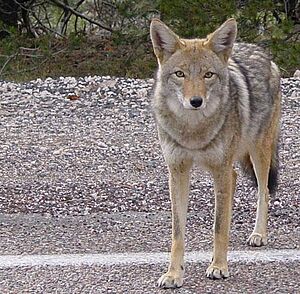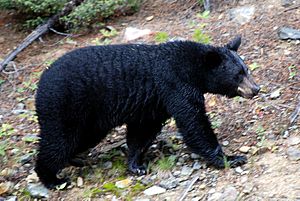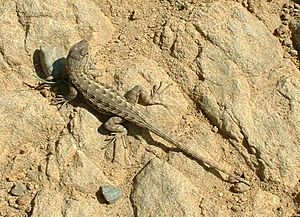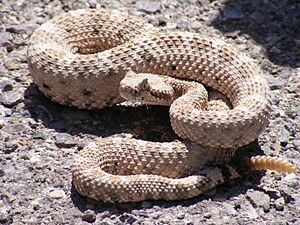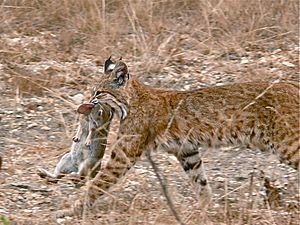Fauna of California facts for kids
California has an amazing variety of animals! It's one of the most diverse states in the USA. This is because California has many different climates, landscapes, and types of land. From hot deserts to cool mountains and foggy coasts, California has many unique places for animals to live. Each of these places has its own special plants and animals.
Scientists often divide California into different land regions. These include the Klamath Mountains, Cascade Range, Modoc Plateau, Basin and Range, Coast Ranges, Central Valley, Sierra Nevada, Transverse Ranges, Mojave Desert, Peninsular Ranges, and Colorado Desert. The Los Angeles Basin, Channel Islands, and Pacific Ocean are also important areas for wildlife.
Many animals live all over California. These include raccoons, weasels, otters, beavers, hawks, lizards, owls, coyotes, skunks, snakes, cougars, black bears, deer, and squirrels. Whales are also common off the coast. California is home to over 600 types of birds. The California quail is the official state bird. Another large bird, the American white pelican, visits California in winter. It has a huge wingspan, reaching up to 280 centimeters (110 inches).
Some spiders in California can be venomous. These include the brown widow and western black widow.
Contents
Animals of Northern California
The forests in Northern California are full of wildlife. You can find animals like the black-tailed deer, black bear, gray fox, cougar, bobcat, and Roosevelt elk. Snakes like garter snakes and rattlesnakes are common. Amphibians such as the mudpuppy and redwood salamander also live here. Birds like the kingfisher, chickadee, towhee, and hummingbird are often seen. Wild horses also live in Northern California. Gray wolves have started to return to California since 2011.
Wildlife in the Sierra Nevada Mountains
The Sierra Nevada mountains are home to many animals. In the higher parts, you might see snowshoe hares and chipmunks. Birds like the blue-fronted jay and hermit thrush are common. As you go higher, birds become fewer. The wolverine is very rare here. The gray-crowned rosy finch is a bird that lives in the highest, coldest areas. Other birds like the Anna's hummingbird and Clark's nutcracker visit these high places.
Other animals in the Sierra Nevada include the Sierra coney and white-tailed jackrabbit. The bighorn sheep also lives in these mountains. The bighorn sheep is a protected animal. In Yosemite Valley, you can find bobcats, mountain lions, ring-tailed cats, Steller's jays, California ground squirrels, and black bears.
Animals of Lake Tahoe
Lake Tahoe is a very large lake on the border of California and Nevada. The area around Lake Tahoe has many different animals. Mammals include the yellow-bellied marmot, Douglas squirrel, golden-mantled ground squirrel, American marten, mule deer, black bear, coyote, raccoon, beaver, and porcupine.
Many birds live around Lake Tahoe. These include the American robin, bald eagle, California gull, Canada goose, and Steller's jay. The region also has venomous spiders like the black widow and brown recluse. The mountain yellow-legged frog lives throughout the area. Fish in the lake include Tahoe sucker, mountain whitefish, and various trout species.
Animals of the Klamath Mountains
The large forests of the Klamath Mountains provide great homes for many animals. Mammals here include mountain lions, black bears, bobcats, lynx, raccoons, martens, fishers, beavers, gray foxes, red foxes, and many deer. Birds like bald eagles, golden eagles, and various hawks and owls are common.
Wolves also live in this area. The Trinity Alps Wilderness is a huge protected area where bears are very common. Hikers are advised to use special bear-proof containers for food. Many rivers in this area have salmon and steelhead fish. Other fish species include king salmon, silver salmon, brown trout, and rainbow trout.
Wildlife in Big Sur
Big Sur is a beautiful coastal area where mountains meet the Pacific Ocean. It is home to many animals. Mammals include bobcats, weasels, coyotes, gray foxes, and pumas. Wild Russian boars, brought here long ago, can now be found in many parts of California. Off the rocky coast, you can spot sea lions, harbor seals, elephant seals, gray whales, sea otters, and different types of sharks.
Many seabirds and waterfowl also live here. These include seagulls, cormorants, willets, sandpipers, and hummingbirds. Andrew Molera State Park alone has over 350 bird species. The peregrine falcon, brown pelican, and Brandt's cormorant are easy to see along the coast. Three types of amphibians live in Big Sur: the arboreal salamander, California newt, and western toad.
Animals of Southern California
Southern California has a very wide range of landscapes. It includes Pacific islands, beaches, coastal plains, mountains, valleys, and vast deserts.
Several types of rattlesnakes live in this region. While Northern California has only one main type, Southern California's deserts are home to almost a dozen rattlesnake species. These include the western diamondback and the Mojave rattlesnake. Birds in Southern California include the Anna's hummingbird, acorn woodpecker, northern flicker, California towhee, California vulture, and red-tailed hawk.
Animals of the Mojave Desert
The Mojave Desert might look empty, but it has many different animals. Desert animals have special ways to live in the hot environment. Animals in the Mojave Desert include the Mohave rattlesnake, desert tortoise, glossy snake, common side-blotched lizard, California kingsnake, giant hairy scorpion, stripe tailed scorpion, and the desert iguana.
Animals of the Sonoran Desert
Mammals found in the Sonoran Desert include the jackrabbit, kangaroo rat, and opossum. Common birds are the Western screech-owl, roadrunner, cactus wren, and various hawks. Reptiles like the sidewinder, desert tortoise, and horned toad also live here. In the higher parts of the Sonoran zone, you can find antelope, brown-footed woodrats, and ring-tailed cats. Unique birds to this area are the California thrasher, American bushtit, and California condor.
Animals of the Colorado River
The Colorado River is the longest river in California. Many animals live along the Colorado River and its surrounding valley. These include several types of snakes, scorpions, tarantulas, yellow-headed blackbirds, desert iguanas, kit foxes, bobcats, and coyotes.
The Colorado River system once had 49 types of native fish, with 42 found nowhere else. Due to changes in the river, four species have disappeared, and 40 species are now at risk. The bonytail chub, razorback sucker, Colorado pikeminnow, and humpback chub are among the most endangered. These fish are special to the Colorado River and are adapted to its natural conditions.
Wildlife on the Californian Coast
Along the Californian Coast, you can find many animals. Raccoons, skunks, opossums, and rats are common. Larger predators include the red fox, bobcat, coyote, black bear, and cougar. Many insects like wasps, European honeybees, yellowjackets, flies, and moths also live here. In the ocean, you might see orcas and great white sharks. The gray fox is more common than the red fox along the coast.
Backyard wildlife
Raccoons, opossums, skunks, and foxes are often seen in yards. Insects, birds, lizards, and squirrels are also common. Bobcats might appear near wild areas. Sometimes, rattlesnakes, coyotes, cougars, and bears can also be seen near homes that are close to wild lands.
Animals of the Channel Islands
Over 2,000 types of plants and animals live in the Channel Islands National Park. This park includes five of the eight California Channel Islands. Three mammals are found only on these islands: the Channel Islands fox, the deer mouse, and the Channel Islands spotted skunk. Other mammals include the harvest mouse, ground squirrel, and ornate shrew.
Other animals on the islands include the island fence lizard, island scrub jay, harbor seal, California sea lion, island night lizard, barn owl, bald eagles, and brown pelican. One hundred and forty-five of these species are unique to the islands and found nowhere else. The oceans around the islands are full of marine life. This ranges from tiny plankton to the endangered blue whale, the largest animal on Earth. Other marine animals include orcas, swellsharks, bat rays, California morays, great white sharks, and sea lions.
Marine Life of Coastal California
Along the coast of California, you can find the California sea lion. These animals can grow up to 2 meters (7 feet) long. They live in shallow ocean water, near beaches, and among rocks. In the open ocean, the northern elephant seal can be found. These massive seals grow up to 4.2 meters (14 feet) long. California's ocean waters are home to six types of seals: the Guadalupe fur seal, northern fur seal, northern sea lion, California sea lion, northern elephant seal, and harbor seal.
California waters also have eleven types of dolphins. These include the short-beaked common dolphin and the Pacific white-sided dolphin. A dozen types of whales live in California, such as the killer whale and the gray whale. At least 34 types of sharks have been seen off the California Coast. These include the great white shark and tiger shark.
See also
 In Spanish: Fauna de California para niños
In Spanish: Fauna de California para niños


